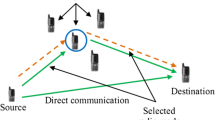Abstract
Green communication has emerged as the most important concept for the next generation networks. Along with improved data rate and capacity, the upcoming 5G networks aim at improving energy efficiency without compromising on the user experience. In this paper, we have used amplify and forward relays in the heterogeneous network topology consisting of low power and high power nodes. A three layered system model for power optimization is discussed using a relay selection strategy for power optimization with the aim to improve energy efficiency of the network. Further, we have used Hidden Markov Model for training and maintaining of base station, relay and SCA with the aim of probabilistic power allocation to client nodes in order to solve the power optimization problem. We have also used adaptive modulation schemes for lowering the power consumption of the network to meet our goal of green communication for the next generation network.














Similar content being viewed by others
Explore related subjects
Discover the latest articles, news and stories from top researchers in related subjects.References
Laurent He’rault, Holistic approach for future energy efficient cellular networks, CEA-LETI, 11th Leti annual review, June 2009.
Feng, D., Jiang, C., Lim, G., Cimini, L. J., Feng, G., & Li, G. Y. (2013). A survey of energy-efficient wireless communications. IEEE Communications Surveys & Tutorials, 15(1), 167–178.
IMT vision-framework and over-all objectives of the future development of IMT for 2020 and beyond, document Rec. ITU-R M.2083-0, September 2015.
EARTH. Energy aware radio and network technologies project. [Online]. Available: https://www.ict-earth.eu/default.html.
Han, C., et al. (2011). Green radio: Radio techniques to enable energy-efficient wireless networks. IEEE Communication Magazine, 49(6), 46–54.
3GPP TR 36.814 v.9.0.0 “Technical specification group radio access network; evolved universal terrestrial radio access (E-UTRA); Further advancements for E-UTRA physical layer aspects,” March 2010.
IEEE standard for local and metropolitan area networks part 16: Air interface for broadband wireless access systems amendment 1: Multi-hop relay specification, IEEE Standard 802.16j, June 2009.
Mesodiakaki, A., Adelantado, F., Alonso, L., & Verikoukis, C. (2017). Joint energy and spectrum efficient user association in millimeter wave backhaul small cell networks. IEEE Transactions on Vehicular Technology, 66(2), 1810–1821.
Mesodiakaki, A., Adelantado, F., Antonopoulos, A., Di Renzo, M., Alonso, L., & Verikoukis, C. (2016). Energy and spectrum efficient user association in 5G heterogeneous networks. In IEEE PIMRC.
Abrol, A., & Jha, R. K. (2016). Power optimization in 5G networks: A step towards green communication. IEEE Access, 4, 1355–1374.
Pabst, R., et al. (2004). Relay-based deployment concepts for wireless and mobile broadband radio. IEEE Wireless Communications Magazine, 42(9), 80–89.
Salem, M., Adinoyi, A., Yanikomeroglu, H., & Falconer, D. (2010). Opportunities and challenges in OFDMA-based cellular relay networks: A radio resource management perspective. Transactions on Vehicular Technology, 59(5), 2496–2510.
Gupta, A., & Jha, R. K. (2015). A survey of 5G network: Architecture and emerging technologies access. IEEE Access, 3, 1206–1232.
Nomikos, N., Skoutas, D. N., & Makris, P. (2014). Relay selection in 5G networks. In Proceedings of the international wireless communications and mobile computing conference (IWCMC) (pp. 821–826).
Bletsas, A., Shin, H., & Win, M. Z. (2007). Cooperative communications with outage-optimal opportunistic relaying. IEEE Transactions on Wireless Communications, 6(9), 3450–3460.
Zou, Y., Zhu, J., Zheng, B., & Yao, Y.-D. (2010). An adaptive cooperation diversity scheme with best-relay selection in cognitive radio networks. IEEE Transactions on Signal Processing, 58(10), 5438–5445.
Altubaishi, E., & Shen, S., (2011). Variable-rate based relay selection scheme for decode-and-forward cooperative networks. In Proceedings of the IEEE wireless communications and networking conference (pp. 1887–1891).
Jing, Y., & Jafarkhani, H. (2009). Single and multiple relay selection schemes and their achievable diversity order. IEEE Transactions on Wireless Communications, 8(3), 1414–1423.
Nomikos, N. K., Charalambous, T., Krikidis, I., Skoutas, D. N., Vouyioukas, D., Johansson, M., et al. (2015). A survey on buffer-aided relay selection. Communications Surveys & Tutorials. doi:10.1109/COMST.2015.2512441.
Nomikos, N., Vouyioukas, D., Charalambous, T., Krikidis, I., Makris, P., Skoutas, D.N., Johansson, M., & Skianis, C. (2013). Joint relay-pair selection for buffer-aided successive opportunistic relaying. Transactions on Emerging Telecommunications Technologies.
Nomikos, N., Nieto, A., Makris, P., Skoutas, D. N., Vouyioukas, D., Rizomiliotis, P., et al. (2015). Relay Selection for Secure 5G Green Communications. Journal Telecommunication Systems, 59, 169–187. doi:10.1007/s1235-014-9890-7.
Chopra, G., Jha, R. K., & Jain, S. (2017). A survey on ultra-dense network and emerging technologies: Security challenges and possible solutions. Journal of Network and Computer Applications, 95(1), 54–78. doi:10.1016/j.jnca.2017.07.007.
Miao, G. W., Himayat, N., & Li, G. Y. (2010). Energy-efficient link adaptation in frequency-selective channels. IEEE Transactions on Communications, 58(2), 545–554.
Phan, K. T., Le-Ngoc, T., Vorobyov, S. A., & Tellambura, C. (2009). Power allocation in wireless multi-user relay networks. IEEE Transactions on Wireless Communications, 8(5), 2535–2545.
Liu, Y., & Petropulu, A. P. (2013). QoS guarantees in AF relay networks with multiple source-destination pairs in the presence of imperfect CSI. IEEE Transactions on Wireless Communications, 12(9), 4225–4335.
Sadek, A. K., Han, Z., & Liu, K. J. R. (2010). Distributed relay-assignment protocols for coverage expansion in cooperative wireless networks. IEEE Transactions on Mobile Computing, 9(4), 505–515.
Parzysz, F., Di Renzo, M., & Verikoukis, C. (2017). Power-availability-aware cell association for energy-harvesting small-cell base stations. IEEE Transactions on Wireless Communications, 16(4), 2409–2422.
Rabiner, L. R. (1989). A tutorial on hidden Markov models and selected applications in speech recognition. Proceedings of the IEEE, 77(2), 257–286.
Further advancements for E-ULTRA physical layer aspects (Release 12), document 3GPP TS 36.942, September 2014.
Acknowledgements
The authors gratefully acknowledge the support provided by 5G and IoT Lab, DoECE, and TBIC-Shri Mata Vaishno Devi University, Katra, Jammu.
Author information
Authors and Affiliations
Corresponding author
Rights and permissions
About this article
Cite this article
Abrol, A., Jha, R.K., Jain, S. et al. Joint power allocation and relay selection strategy for 5G network: a step towards green communication. Telecommun Syst 68, 201–215 (2018). https://doi.org/10.1007/s11235-017-0385-1
Published:
Issue Date:
DOI: https://doi.org/10.1007/s11235-017-0385-1




